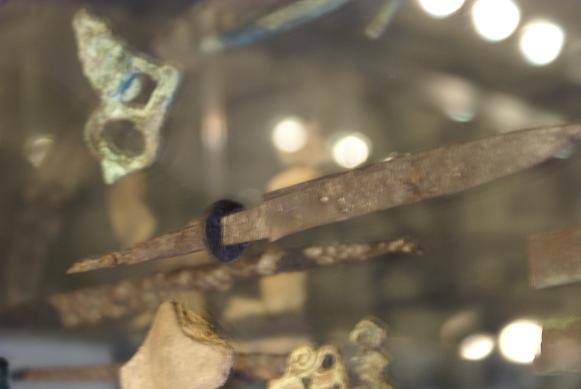| Author |
Message |
|
Sabine Benning
|
 Posted: Sun 08 Mar, 2009 7:36 am Post subject: unkown dagger! Posted: Sun 08 Mar, 2009 7:36 am Post subject: unkown dagger! |
 |
|
Help requested!
What is this for a knife? Time and nature are unknown to me. Has someone an idea?
Unfortunately missing the pommel.
Thank you and many greetings to all interested!
---------------------------------
Sorry for bad english!
S.Benn
|
|
   |
 |
|
Sabine Benning
|
 Posted: Sun 08 Mar, 2009 7:40 am Post subject: Re: unkown dagger! Posted: Sun 08 Mar, 2009 7:40 am Post subject: Re: unkown dagger! |
 |
|
| Sabine Benning wrote: | Help requested!
Oops, second attempt! Sorry, no picture!
What is this for a knife? Time and nature are unknown to me. Has someone an idea?
Unfortunately missing the pommel.
Thank you and many greetings to all interested!
---------------------------------
Sorry for bad english! |
 Attachment: 48.18 KB Attachment: 48.18 KB

S.Benn
|
|
   |
 |
Etienne Hamel

Location: Granby (QC) canada Joined: 09 Sep 2006
Posts: 443
|
 Posted: Sun 08 Mar, 2009 9:00 am Post subject: Posted: Sun 08 Mar, 2009 9:00 am Post subject: |
 |
|
|
It looks like a small seax but for the period im not enough documented...
|
|
  |
 |
|
Hadrian Coffin
Industry Professional
Location: Oxford, England Joined: 03 Apr 2008
Posts: 404
|
 Posted: Sun 08 Mar, 2009 9:31 am Post subject: Posted: Sun 08 Mar, 2009 9:31 am Post subject: |
 |
|
Hello,
It looks like a small broken-back seax from c. 800-1100. You said it is missing its pommel, though I doubt it ever had one. From the picture it appears to be a wittle tang knife which means the grip of wood/antler/bone was glued directly onto the tang. The "guard" though unusual is not unheard of (see picture below).
The difficulty in dating a knife like this is that this shape appears frequently throughout history, I have seen Roman knives in this shape to modern American Bowie knives, so without seeing the piece in person take what I have said as an educated guess.
Do you have any measurements (width, length, thickness at spine, etc.) as these would help, also a few more pictures from a few other angles.
Best,
Hadrian
 Attachment: 54.21 KB Attachment: 54.21 KB

Viking era knife
|
|
   |
 |
|
Sabine Benning
|
 Posted: Sun 08 Mar, 2009 10:33 am Post subject: Posted: Sun 08 Mar, 2009 10:33 am Post subject: |
 |
|
Hello Etienne and Hadrian,
thank you for postings.
Total length is 22 cm (8,661 inch), length of blade is 12 cm (4,7 inch). Hope the inches are correct determined.
First I also thought it could be small seax. But is there a similar small seax with that form of blade-catcher? I am not sure.
The second idea I have: it is a modern knive, 20.th century.
Or may be a an older one, a special kind of knive for peasants…
greetings
S.Benn
|
|
   |
 |
R D Moore

|
 Posted: Sun 08 Mar, 2009 11:09 am Post subject: Posted: Sun 08 Mar, 2009 11:09 am Post subject: |
 |
|
With a blade length of 4.7 inches, and if the shape of the point has remained true to form, it could be a pen knife similar to those found in "Knives and Scabbards"
"No man is entitled to the blessings of freedom unless he be vigilant in its preservation" ...Gen. Douglas Macarthur
|
|
   |
 |
|
Sabine Benning
|
 Posted: Sun 08 Mar, 2009 12:06 pm Post subject: Posted: Sun 08 Mar, 2009 12:06 pm Post subject: |
 |
|
Hello R.D.
thank you for answer. I do not know that book. Time to chance  ! Becauce im really interested in medieval daggers and knives. ! Becauce im really interested in medieval daggers and knives.
Can you explain what a pen knive is?
greetings
S.Benn
|
|
   |
 |
Leo Todeschini
Industry Professional

|
|
   |
 |
|
Robin Palmer
Location: herne bay Kent UK Joined: 21 Dec 2007
Posts: 138
|
 Posted: Mon 09 Mar, 2009 4:00 am Post subject: Posted: Mon 09 Mar, 2009 4:00 am Post subject: |
 |
|
Hi sabine.
I agree it is a sax but would point out that the sax style was made for a lot longer than most people think there is a sax style blade in the museum of London dating to the mid to late 1400s. The original bowie design was sax in fact the bowie is simply a modification of the sax design the style is still used in Iceland as a fisher mans knife. I suspect your blade could be middle ages onwards the guard makes it unlikely to be viking Saxon..
yours Bob palmer.
|
|
   |
 |
Bjorn Hagstrom

|
 Posted: Mon 09 Mar, 2009 4:45 am Post subject: Posted: Mon 09 Mar, 2009 4:45 am Post subject: |
 |
|
As always, more information can help is narrow the scope. For example: Where was it found, and under what circumstances? Does it have a context? Northern Europe, Central Europe or something else?
To me, unless it has a good reason for being medieaval or earlier (such as being found at an archaeological site, or acquired from a collection) it is most likely not. My best guess would be an "early modern" utility knife say 19th/early 20th century.
There is nothing quite as sad as a one man conga-line...
|
|
   |
 |
|
|

